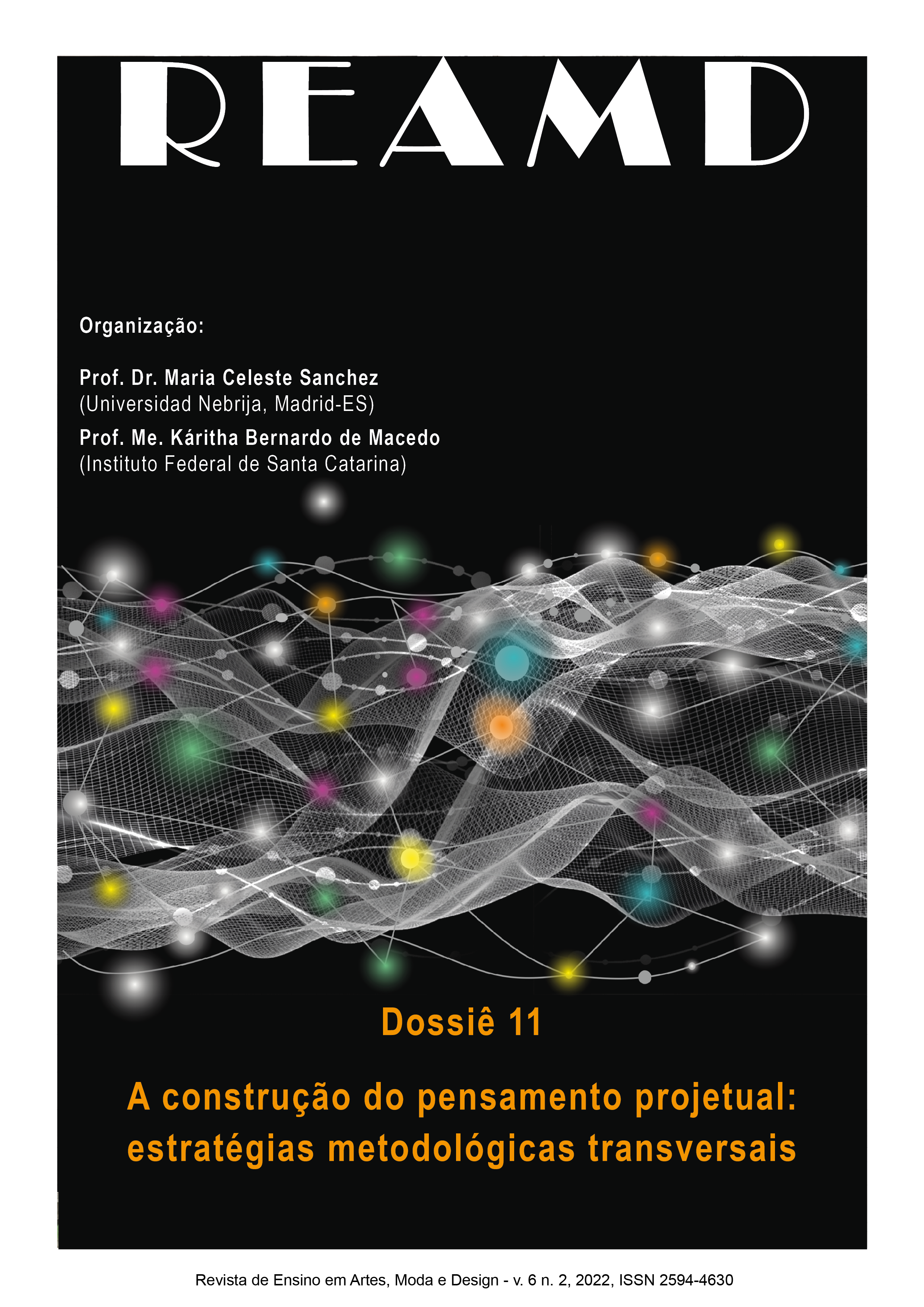Analysis of design methodologies and development of useful tools for the creative process of the fashion designer
DOI:
https://doi.org/10.5965/25944630622022e1668Keywords:
Fashion design methodology, Semantic references, PDPAbstract
Project thinking in design deals with diverse information, among which: subjective information that acts in the cultural construct of complex social interactions, and that will serve the designer as a connection between the product and the consumer. This research aimed to analyze fashion design methodologies and develop useful tools for the fashion designer’s creative process. It was done with a theoretical approach, from the theoretical framework, and practice, through a survey applied in August 2020, with 5 professionals from different areas of fashion, from different cities of Santa Catarina, to verify the use of methods and tools recognition of symbolic references in fashion. This research was constituted by the interdisciplinary approach, uniting semantics, semiotics, and cognitive ergonomics, in the search for tools and methods to aid in the designer’s interpretive process, and to contribute to interdisciplinarity and interpretive systematization in design thinking. We sought to recognize methodologies applied in the Product Development Process (PDP), the tools used or recognized, and the semantic references of fashion. The result is the synthesis of the PDP for fashion design, the useful tools coming from the semiotic theory of Peirce (2005), and Greimas (1984), and from the semantic memory of Mervis & Rosch (1987). The observation of the need for interpretive tools culminated in the elaboration of cards of aesthetic, symbolic and fashion style references, to serve as tools, and constitute themselves as a method. On the data obtained, the content analysis methodology was used (BARDIN, 2016).
Downloads
References
AMARO. Jaqueta de Leather gola removível. 2021a. Disponível em https://amaro.com/br/pt/c/moda-feminina/roupas/jaquetas/50300508_0002/jaqueta-de-leather-gola-removivel/preto. Acesso em 19.06.2021.
BARDIN, Laurence. Análise de Conteúdo. 3. Reimpressão. São Paulo: Edições 70, 2016.
BONA, Sheila Fernanda. Método de projeto de coleção em design de moda: uma configuração para micro e pequenas empresas. 2019. 138 f. Dissertação (Mestrado) - Curso de Curso de Mestrado do Programa de Pós-Graduação em Moda, Área de Concentração Design e Tecnologia do Vestuário, Ceart, Universidade do Estado de Santa Catarina, Florianópolis, 2019. Disponível em: https://www.udesc.br/arquivos/ceart/id_cpmenu/6295/Disserta__o_Sheila_Fernanda_Bona_15816930311845_6295.pdf. Acesso em: 11 ago. 2021.
BRASIL. Ministério da Educação. CNE. Resolução n. 5, de 8 de março de 2004. Brasília, 8 mar. 2004. Disponível em: http://portal.mec.gov.br/cne/arquivos/pdf/rces05_04.pdf. Acesso em: 02.05.2021.
BUTLER, Judith. Problemas de gênero. Feminismo e subversão da identidade. Rio de Janeiro: Civilização Brasileira, 2018.
CHAUVEL, Lucrecia Escudero. Cambio de tendencias y paradigmas. In: GAGO, José Maria Paz; TERRACCIANO, Bianca; NANNINI, Victoria (orgs.). Volver a la Moda... em la Web. DeSignis Serie Intersecciones. Rosario: UNR editora, 2020. Pp.9-14.
FUENTES, R. A prática do Design Gráfico: uma metodologia criativa. São Paulo: Rosari, 2006.
GOMES FILHO, João. Gestalt do objeto. Sistema de leitura visual da forma. 8ª ed. São Paulo: Escrituras, 2008.
GREIMAS, Algirdas Julius. Semiótica figurativa e semiótica plástica. Significação, n.4, julho de 1984.
JORNAL DAS MOÇAS. 1732. Rio de Janeiro, 26.08.1948.
KRIPPENDORFFF, Klaus. The semantic turn: a new foundation for design. Boca Raton: Taylor & Francis Group, 2006.
MERVIS, Carolyn B.; ROSCH, Eleanor. Categorization of natural objects. Revista Psychol. 1981, pp.89-115.
MUKAROVSKI, Jan. Signo, función y valor. Estética y semiótica del arte de Jan Mukarovski. Tradução de Jarmila Jandová e Emil Volek. Bogotá: Plaza & Janés Editores Colombia S.A., 2000.
OLIVEIRA, Sandra Ramalho. Moda também é texto. São Paulo: Rosari, 2007.
PANIZZA, Janaína Fuentes. Metodologia e processo criativo de projetos em comunicação visual. São Paulo: USP, 2004. Dissertação de Mestrado, Escola de Comunicação e Artes, Universidade do Estado de São Paulo, 2004. 254fls.
PEIRCE, Charles Sanders. Semiótica. 3ªed.Tradução de José Teixeira Coelho Neto. São Paulo: Perspectiva, 2005.
SANCHES, Maria Celeste de Fátima; MARTINS, Sérgio Regis Moreira. Projetando mensagens visuais: a contribuição das ferramentas de síntese imagética no design de moda. Estudos em design, v.23, n.1, 2015. Pp.108-117. Disponível em < https://estudosemdesign.emnuvens.com.br/design/article/view/200/177>. Acesso em 02.07.2021.
SANTOS, Celio Teodorico dos. Requisitos de linguagem do produto: uma proposta de estruturação para as fases iniciais do PDP. 2009. 214 f. Tese (Doutorado) - Curso de Engenharia Mecânica, Universidade Federal de Santa Catarina, Florianópolis, 2009. Disponível em: https://repositorio.ufsc.br/handle/123456789/92478. Acesso em: 18 ago. 2021.
SCOZ, Emanuella et.al. A ROUPA. A evolução da Roupa em sua Relação com a sociedade. Do ano 1000 d.C. até o século XX. 2ªed. Blumenau: AmoLer, 2019.
STERNBERG, Robert J. Psicologia cognitiva. Tradução da 5ª edição norte americana, por Anna Maria Dalle Luche e Roberto Galman. São Paulo: Cengage Learning, 2010.
WDO. World Design Organization. Definição de desenho industrial. 2021. Disponível em <https://wdo.org/about/definition/>. Acesso em 01.07.2021.
Published
How to Cite
Issue
Section
License
Copyright (c) 2022 Emanuella Scoz, Celio Teodorico

This work is licensed under a Creative Commons Attribution 4.0 International License.
- Authors retain copyright and grant the journal the right of first publication, with work simultaneously licensed under the Creative Commons Attribution 4.0 International License, which allows for:
1. Share — copy and redistribute the material in any medium or format for any purpose, even commercially.
2. Adapt — remix, transform, and build upon the material for any purpose, even commercially.
The licensor cannot revoke these freedoms as long as you follow the license terms.Under the following terms:
1. Attribution — You must give appropriate credit, provide a link to the license, and indicate if changes were made. You may do so in any reasonable manner, but not in any way that suggests the licensor endorses you or your use.
2. No additional restrictions — You may not apply legal terms or technological measures that legally restrict others from doing anything the license permits. -
Plagiarism, in all its forms, constitutes unethical publication behavior and is unacceptable. This magazine uses iThenticate similarity control software.






